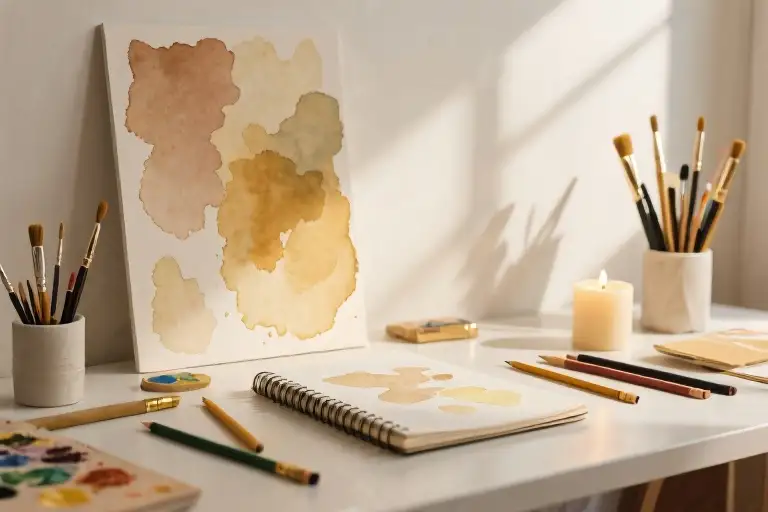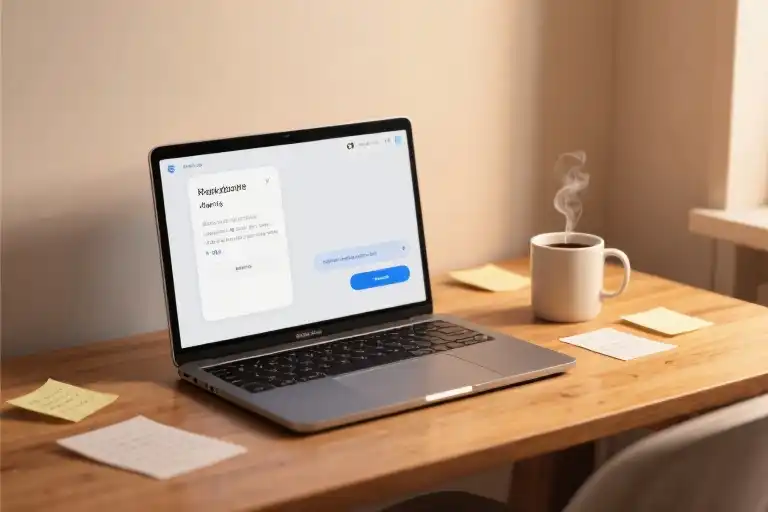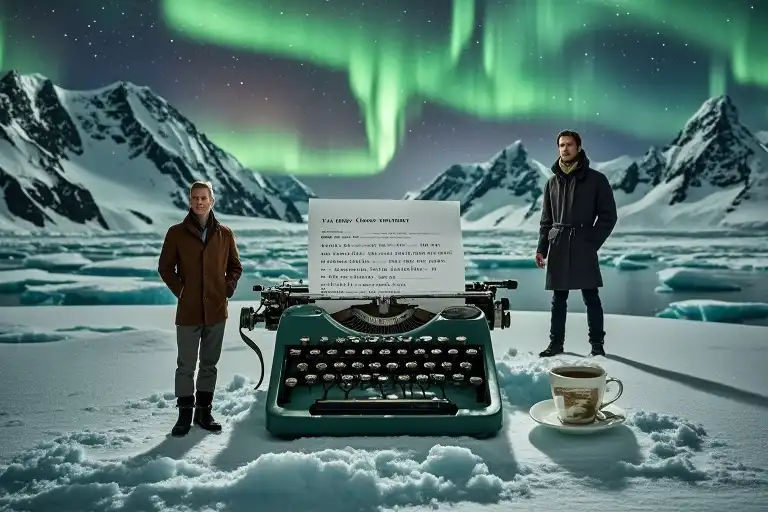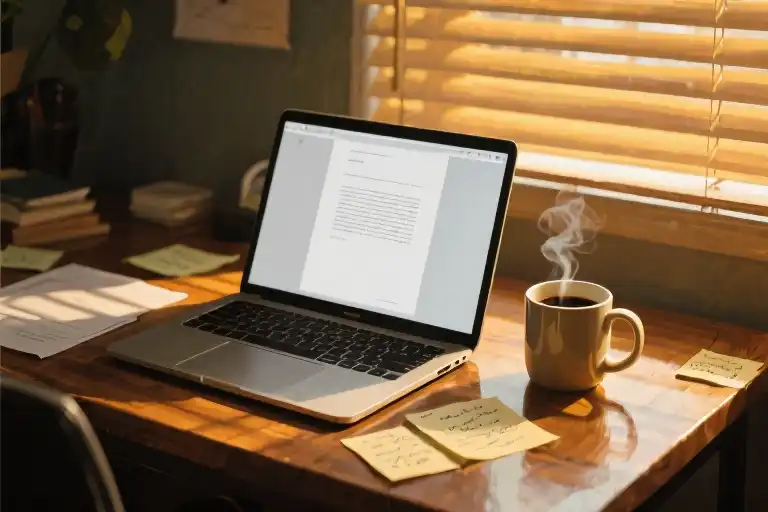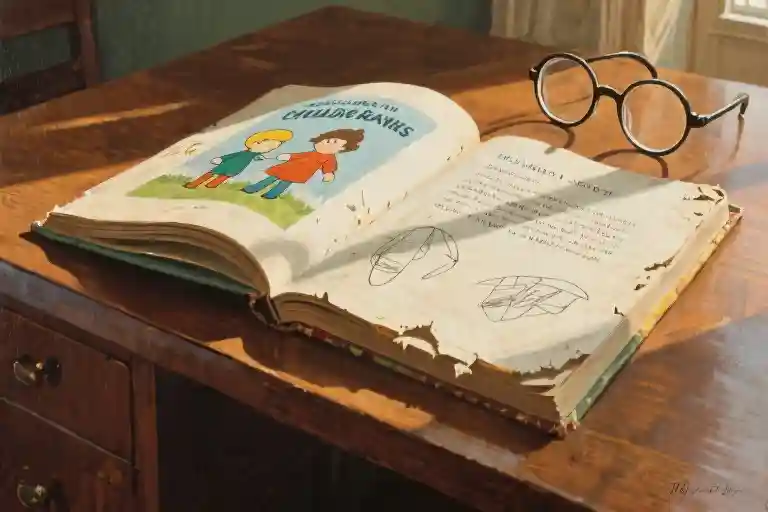The cursor blinks mockingly on the empty document. Across the studio, half-finished canvases lean against the wall like silent accusers. Your guitar case gathers dust in the corner while unpaid invoices stack up on the desk. This wasn’t how it was supposed to feel – turning the work you love into the grind that drains you.
Creative burnout doesn’t announce itself with dramatic fanfare. It creeps in during those late-night sessions when commercial projects eclipse personal ones, when metrics start dictating your artistic choices, when the act of creation begins feeling like emotional withdrawal rather than deposit. The cruel irony? The more successful you become at monetizing your craft, the easier it is to lose the very spark that made your work valuable in the first place.
Here’s what nobody tells you during the hustle: creative block isn’t a talent deficiency. That paralysis you feel when facing a blank page or silent studio isn’t evidence you’re ‘not cut out for this.’ It’s simply your creative spirit signaling it’s time for recalibration – not through self-flagellation, but through compassionate curiosity.
After a decade of oscillating between frenzied output and creative droughts, I’ve learned this pattern the hard way: when creation becomes purely transactional, we stop listening to our artistic intuition. The solution isn’t working harder, but remembering to ask better questions. What follows are eight simple yet powerful inquiries that have repeatedly helped me (and countless creators I’ve coached) reconnect with our creative core. They require no special tools – just honesty and willingness to pause mid-race.
These questions work because they bypass the critical mind and speak directly to the creative subconscious. They’re not about diagnosing failures (‘Why can’t I finish anything?’) but about rediscovering alignment (‘What conditions make creation feel effortless?’). Some might seem deceptively simple, but don’t let that fool you – their power lies in how they reframe our relationship with creativity from obligation back to exploration.
Consider this your artistic reset button. Whether you’re a novelist battling deadline fatigue, a designer losing your visual voice to client demands, or a musician who hasn’t played for pleasure in months, what comes next is space to remember who you are when nobody’s watching, paying, or judging your work.
When Creating Feels Like a Burden
There comes a point in every creative journey when the brush feels heavier than usual, the blank page stares back a little longer, and the melodies that once flowed effortlessly now seem stuck in some distant corner of your mind. If this resonates with you, you’re not alone. Nearly three-quarters of professional artists report experiencing creative burnout at some point, according to a recent survey by the Creative Independent.
The Weight of Commercial Pressures
When creativity becomes your livelihood, an invisible shift occurs. That experimental novel you’ve been dreaming about gets postponed for client deadlines. The personal art series collects dust while you churn out algorithm-friendly content. What began as self-expression gradually transforms into a series of deliverables measured by engagement metrics and payment terms.
I remember the exact moment I realized my sketchbook hadn’t seen a new drawing in six months – not for lack of ideas, but because every creative impulse got funneled into billable work. The irony? The more successful I became commercially, the emptier my personal creative reservoir felt.
The Algorithm Anxiety Cycle
Digital platforms have introduced a new layer of creative pressure. We find ourselves unconsciously molding our art to fit trending formats, chasing viral validation rather than authentic expression. The writer tweaks their voice to match popular SEO keywords. The musician produces shorter hooks optimized for TikTok attention spans. Each view count becomes both reward and shackle.
A painter friend confessed she’d started choosing subjects based on Instagram color palette trends rather than what moved her. “I got 30% more likes,” she said, “and 100% less satisfaction.”
The Silent Struggle of Self-Doubt
Beneath these external pressures lies something more insidious – the creeping suspicion that maybe we’re not “real” artists after all. Imposter syndrome thrives in creative fields, whispering that our work isn’t original enough, skilled enough, meaningful enough. This internal critic often speaks loudest when we’re most exhausted, creating a vicious cycle of doubt and creative paralysis.
Pushing Harder Isn’t the Answer
Conventional productivity advice fails creatives spectacularly. “Just show up every day” or “treat it like a job” might work for spreadsheet tasks, but forcing creativity under pressure often backfires. Neuroscience shows that creative thinking flourishes in relaxed states of mind, not under the lash of self-criticism.
I learned this the hard way during a particularly brutal deadline period. Forcing myself to work 12-hour days resulted in technically proficient but utterly soulless work – and left me so drained I couldn’t create anything personal for months afterward.
The Alternative: Compassionate Inquiry
What if instead of demanding more from our exhausted creative selves, we got curious about what’s happening beneath the surface? Psychological research on self-compassion demonstrates that treating ourselves with kindness during creative blocks actually leads to faster recovery than self-punishment.
Dr. Kristin Neff’s studies at the University of Texas reveal that self-compassionate individuals:
- Experience less creative anxiety
- Maintain more consistent creative output
- Report higher satisfaction with their creative process
This isn’t about making excuses – it’s about creating the mental conditions where creativity can safely re-emerge. The following section explores how specific reflective questions can help us do exactly that.
Why We Need to Pause and Ask Ourselves
There comes a point in every creative journey when the brush feels heavier, the blank page stares back longer, and the melodies that once flowed effortlessly now seem just out of reach. This isn’t artistic failure—it’s the inevitable ebb and flow of creative work. What separates those who navigate these tides successfully from those who drown in frustration often comes down to one simple practice: the art of self-questioning.
The Science Behind Creative Reflection
Neuroscience reveals something fascinating about how our brains generate ideas. Creativity isn’t a constant stream but a cyclical process requiring both engagement and rest. Studies on default mode network activation show that our most original ideas often emerge during periods of reflection, not forced productivity. When we step back to ask ourselves meaningful questions, we’re not being lazy—we’re activating the brain’s natural creative problem-solving mode.
Consider how children create: with unabashed joy, no concern for algorithms or marketability. As professional creatives, we’ve layered complex expectations over that innate impulse. The eight questions we’ll explore work like mental archaeology tools, helping scrape away accumulated pressures to reveal your foundational creative impulses.
Critical Self-Talk vs. Compassionate Curiosity
Here’s where most productivity advice fails creatives. Traditional ‘power through it’ approaches often exacerbate creative blocks because they stem from self-criticism (‘Why can’t I just work faster?’). Psychology research demonstrates that self-compassion—not self-flagellation—consistently predicts creative recovery:
- Motivation Studies: When researchers at UC Berkeley analyzed creative professionals, those practicing self-compassion showed 23% greater persistence after failures
- Flow State Research: Judgmental self-talk activates the brain’s threat response, directly inhibiting the relaxed focus needed for creative flow
- Artistic Output: A Goldsmiths University study tracked two groups of writers—one using critical reflection, the other compassionate questioning. The latter group produced 40% more publishable work over six months
This explains why our eight questions frame reflection as exploration rather than interrogation. Instead of ‘Why am I so blocked?’ (which triggers defensiveness), we ask ‘When did I last feel creatively free?’ This subtle shift invites insight without activating the inner critic.
The Rhythm of Creative Check-Ins
Like tending a garden, creative energy requires regular but not constant attention. Through working with hundreds of artists, I’ve observed a pattern: those who thrive long-term establish rituals of reflection. Some examples:
- A graphic designer who reviews her ‘joy log’ (notes on projects that felt fulfilling) every quarter
- A novelist who begins each writing month by answering three simple questions in his studio journal
- A ceramicist who takes a solo ‘artistic retreat’ twice yearly to reassess directions
These aren’t elaborate processes—often just 20 minutes of honest self-dialogue. Yet they function like creative compass recalibrations, preventing the gradual drift away from one’s authentic voice that plagues so many professionals.
What makes these questions different from typical journal prompts? They’re designed specifically to:
- Disarm Perfectionism (e.g., ‘What could I create if no one would judge it?’)
- Surface Hidden Pressures (‘When did external expectations last alter my work?’)
- Reconnect to Play (‘What childhood creative activity have I abandoned?’)
In our next section, we’ll unpack these questions systematically. But first, consider this: the very act of pausing to read this article signals your subconscious already knows—sometimes the most productive thing a creative can do is temporarily stop ‘producing,’ and simply ask.
The Three Layers of Creative Self-Reflection
When facing creative burnout, structured self-inquiry works like peeling an onion. These eight questions aren’t random – they’re carefully designed to reveal different dimensions of your creative psyche. Let’s explore them through three purposeful layers.
Layer 1: Reigniting Your Creative Spark (Motivation Questions)
- “What do I create when no one is watching?”
This cuts through performative creativity. That children’s book draft in your drawer or the abstract paintings never posted on Instagram? Those hold clues to your purest creative impulses. When answering, notice physical reactions – a quickened heartbeat or spontaneous smile indicates deep alignment. - “What childhood creative memory still lights me up?”
Neuroscience confirms early artistic experiences shape our creative identity. Describe your eight-year-old self building forts or writing plays. The sensory details (smell of crayons, texture of construction paper) often reveal forgotten joys. - “Which creation made me lose track of time recently?”
Flow state researcher Mihaly Csikszentmihalyi found timeless engagement signals intrinsic motivation. Was it designing that ceramic mug or composing that chord progression? The activity itself matters less than the absorption quality.
Writer’s note: My answers to these exposed a painful truth – I’d stopped writing poetry, my first creative love, because it “wasn’t marketable.”
Layer 2: Diagnosing Creative Blockages (Pressure Questions)
- “When did I last feel creatively free?”
Creative constraints (client briefs, algorithms) often creep in unnoticed. One illustrator realized her last truly free moment was sketching on a beach vacation – leading her to institute “no-commercial-work Sundays.” - “What outside voice lives rent-free in my creative mind?”
We internalize critics – a professor’s harsh critique or social media comparisons. Naming them (e.g., “My MFA workshop group”) reduces their power. Try visualizing eviction notices for these mental squatters. - “What practical stressor most clouds my creativity now?”
Financial anxiety? Childcare logistics? Normalize addressing these directly. A ceramicist solved her creative blocks by hiring a part-time bookkeeper, freeing mental space.
Layer 3: Charting Your Creative Future (Direction Questions)
- “What legacy do I want my art to leave?”
Not about fame but impact. A muralist realized she wanted her work to “make cities feel loved” – which guided her toward community projects over gallery shows. - “What creative risk have I been avoiding?”
The hesitation itself points to growth edges. For me, it was submitting literary essays after years of commercial writing. The question’s power lies in its gentle confrontation.
Pro Tip: Answer one category per sitting. Motivation questions over morning coffee, pressure questions during an afternoon walk, and direction questions with evening journaling. This honors your brain’s natural rhythm.
Beyond Answers:
Your responses will likely cluster around themes – perhaps freedom versus stability, or private versus public creation. These tensions aren’t problems to solve but creative forces to balance. The songwriter who identified “lyrics about nature” as her joy and “album deadlines” as her stress crafted a solution: monthly camping trips with a voice recorder.
Remember, creativity thrives in paradox. Your answers might seem contradictory (“I love detailed oil painting” and “I crave spontaneous expression”), but the friction between them could birth your next breakthrough style.
Turning Answers Into Action
You’ve done the hard part – you’ve asked yourself those eight raw, revealing questions and sat with the answers. Maybe some responses surprised you, others confirmed what you already knew in your gut. Now comes the transformative work: translating those insights into tangible creative practices that realign you with your artistic core.
Mapping Your Creative Compass
First, let’s visualize your responses through three key lenses:
- Energy Sources (What conditions make creation feel effortless?)
- Blockage Points (Where does resistance typically show up?)
- North Stars (What deeper purpose wants expression through your work?)
Take my friend Elena, a ceramic artist who discovered through these questions that her most fulfilling work happened during:
- Early mornings before client emails
- Experimental phases with no finished product expectations
- Community collaborations rather than isolated studio time
Her action plan became beautifully simple: protect Tuesday/Thursday mornings for “playtime with clay,” and initiate quarterly co-creation projects with local weavers.
Micro-Actions That Actually Stick
Resist the urge for grand overhauls. Lasting creative recovery happens through sustainable tweaks:
| If your answers revealed… | Try this micro-action |
|---|---|
| “I create best when disconnected from digital noise” | Implement 90-minute “airplane mode” creative sprints |
| “My work flows after experiencing other art forms” | Schedule monthly “inspiration dates” (gallery walks, concerts) |
| “I lose motivation when overly focused on outcomes” | Start sessions by creating “ugly drafts” or “throwaway pieces” |
Graphic designer Mark shared how the “ugly drafts” practice liberated him: “Knowing these sketches would immediately get deleted removed all pressure. Ironically, those became the sessions where my best logo concepts emerged.”
Building Your Creative Early Warning System
Those blockage points you identified? They’re gold. Create personalized red flags:
- When you notice ________ (e.g., checking social media mid-creation)
- When you start feeling ________ (e.g., physically tense during painting)
- When you hear yourself say ________ (e.g., “This has to go viral”)
Pair each with a reset ritual – three deep breaths, a walk around the block, or revisiting an old piece you’re proud of. These become your artistic circuit breakers.
The 15-Minute Creative Reboot
For days when even micro-actions feel impossible:
- Set a timer for 15 minutes
- Use whatever medium feels least intimidating (sticky notes, voice memos)
- Create the worst possible version of something – intentionally
Novelist Jamila uses this when stuck: “Writing deliberately terrible paragraphs tricks my perfectionism. By minute 10, I’m usually editing them into usable material.”
Remember: This isn’t about fixing your creativity permanently. It’s about developing loving attention to what your creative spirit needs today – then having the courage to honor that.
Building a Sustainable Creative Health Plan
Creativity isn’t a faucet you can turn on and off at will—it’s more like a garden that needs regular tending. After working through those eight reflective questions, you’ve likely uncovered some valuable insights about your creative motivations, pressures, and aspirations. Now comes the essential part: turning those revelations into lasting habits that nurture your artistic spirit.
The Quarterly Creative Check-In
Think of your creativity like an annual physical exam, but with more frequent touchpoints. Setting reminders every three months to revisit these eight questions creates a rhythm of self-awareness that prevents creative burnout. Here’s why this cadence works:
- Seasonal Alignment: Our creative energy naturally ebbs and flows with the year’s cycles (spring’s renewal, autumn’s introspection)
- Project Cycles: Most creative endeavors have 90-day natural milestones
- Preventative Care: Catching creative blocks early before they become crises
I keep a dedicated journal (mine’s a beautifully worn leather notebook) for these quarterly sessions. The ritual matters—I brew my favorite tea, sit by the window where the light changes through the seasons, and give myself permission to write messy, unfiltered answers.
From Insights to Systems
Remember that answer about creating most freely when you feel playful? Let’s build systems around that:
- Play Dates: Block two Friday afternoons monthly for experimental creation with no outcomes
- Inspiration Triggers: Keep a “creative play kit” (mine includes watercolors, word magnets, and a vintage camera)
- Accountability: Partner with another artist for monthly “show and tell” of your playful projects
For those who discovered financial pressures were stifling creativity, consider:
- The 80/20 Rule: 80% income-generating work, 20% passion projects
- “Artistic Sabbaticals”: One week per quarter focused solely on personally meaningful work
Resources for the Journey
These tools have supported my creative health plan:
- The Artist’s Way Morning Pages: Three handwritten stream-of-consciousness pages upon waking
- Creative Sandbox Hours: Timed 45-minute sessions with varied prompts (try the “Oblique Strategies” cards)
- Analog Tracking: A simple wall calendar with color-coded stickers for different creative activities
What Comes Next
This isn’t where our conversation ends—it’s where your personalized creative practice begins. Next month, we’ll explore mindfulness techniques specifically tailored for artists, including:
- Sensory meditation to sharpen creative observation
- Walking as a compositional tool (ask any poet or songwriter)
- The “empty studio” practice for overcoming creative blocks
For now, take that first step. Mark your calendar three months from today—not with dread, but with the anticipation of checking in with your most creative self. Because here’s the secret no one tells you: The answers change. And that’s exactly as it should be.
“The creative habit is like a pet—feed it daily and take it for walks.”
—Twyla Tharp
Closing Thoughts: Creativity as a Lifelong Journey
At the heart of every creative endeavor lies not perfection, but exploration. This truth often gets buried under deadlines, algorithms, and the relentless chase for external validation. If there’s one thing I hope you take away from these eight questions, it’s this: your creative practice deserves the same kindness and patience you’d extend to a dear friend learning a new skill.
The Gift of Imperfect Progress
Creative blocks aren’t failures—they’re invitations to dig deeper. When novelist Toni Morrison faced writer’s block, she famously asked herself: “Does this book truly need to exist?” That radical self-honesty, free from self-flagellation, allowed her to produce seminal works. Your answers to these reflection questions serve the same purpose: they’re compasses, not cudgels.
Consider this your permission slip:
- To create messy first drafts that delight only you
- To abandon projects that no longer spark joy
- To measure progress in curiosity rather than output
Your Creative Health Toolkit
To keep this conversation alive, I’ve created a Creative Self-Check Workbook (no email required) with:
- Expanded versions of all eight questions
- A “Creative Vital Signs” tracker for quarterly check-ins
- Blank pages designed for doodles as much as writing
The Question I’ll Leave You With
In the comments below, I’d love to hear:
“What’s one small creative act that made you feel truly alive recently?”
It could be stacking pebbles during your morning walk, humming a melody while doing dishes, or finally trying that abstract acrylic technique. Because sometimes, remembering why we create begins with celebrating how we already do.
Further Resources
- The Artist’s Way by Julia Cameron (especially the “Morning Pages” practice)
- Keep Going by Austin Kleon (for when motivation wanes)
- #100DayProject community (accountability without pressure)
Your creative journey is uniquely yours—may it be more playground than proving ground.

